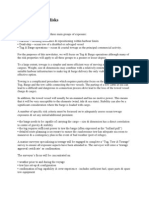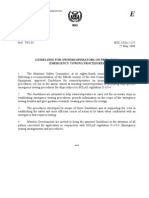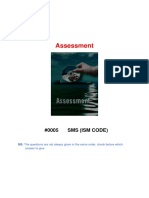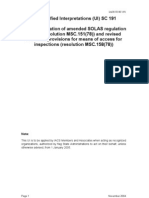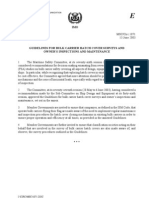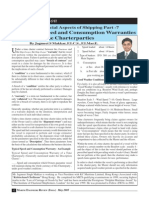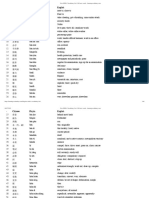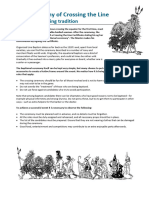MSC.1 Circ.1331
MSC.1 Circ.1331
Uploaded by
Nur Salim ArisCopyright:
Available Formats
MSC.1 Circ.1331
MSC.1 Circ.1331
Uploaded by
Nur Salim ArisCopyright
Available Formats
Share this document
Did you find this document useful?
Is this content inappropriate?
Copyright:
Available Formats
MSC.1 Circ.1331
MSC.1 Circ.1331
Uploaded by
Nur Salim ArisCopyright:
Available Formats
INTERNATIONAL MARITIME ORGANIZATION 4 ALBERT EMBANKMENT LONDON SE1 7SR Telephone: 020 7735 7611 Fax: 020 7587
3210
E
IMO MSC.1/Circ.1331 11 June 2009
Ref. T4/3.01
GUIDELINES FOR CONSTRUCTION, INSTALLATION, MAINTENANCE AND INSPECTION/SURVEY OF MEANS OF EMBARKATION AND DISEMBARKATION 1 The Maritime Safety Committee, at its eighty-sixth session (27 May to 5 June 2009), with a view to providing specific guidance on the construction, installation, maintenance and inspection/survey of means of embarkation and disembarkation such as accommodation ladders and gangways required under regulation II-1/3-9 of the 1974 SOLAS Convention, approved the Guidelines for construction, installation, maintenance and inspection/survey of means of embarkation and disembarkation, prepared by the Sub-Committee on Ship Design and Equipment at its fifty-second session, as set out in the annex. 2 Member Governments are invited to bring the attached Guidelines to the attention of shipowners, shipbuilders, designers, manufacturers, port State control authorities and other parties concerned in conjunction with SOLAS regulation II-1/3-9 (Means of embarkation on and disembarkation from ships). ***
I:\CIRC\MSC\01\1331.doc
MSC.1/Circ.1331 ANNEX GUIDELINES FOR CONSTRUCTION, INSTALLATION, MAINTENANCE AND INSPECTION/SURVEY OF MEANS OF EMBARKATION AND DISEMBARKATION 1 APPLICATION
This document is intended to provide Guidelines for the construction, installation, maintenance and inspection/survey of means of embarkation and disembarkation required under regulation II-1/3-9 of the 1974 SOLAS Convention, adopted by resolution MSC.256(84). Where means of embarkation and disembarkation other than those specifically covered by these Guidelines are fitted, an equivalent level of safety should be provided. 2 CONSTRUCTION
2.1 Accommodation ladders and gangways for means of embarkation and disembarkation which are provided on board ships constructed on or after 1 January 2010 should meet applicable international standards such as ISO 5488:1979, Shipbuilding accommodation ladders, ISO 7061:1993, Shipbuilding aluminium shore gangways for seagoing vessels and/or national standards and/or other requirements recognized by the Administration. Such accommodation ladders and gangways fitted on ships constructed before 1 January 2010, which are replaced after that date, should, in so far as is reasonable and practicable, comply with these Guidelines. 2.2 The structure of the accommodation ladders and gangways and their fittings and attachments should be such as to allow regular inspection, maintenance of all parts and, if necessary, lubrication of their pivot pin. Special care should be taken to ensure that the welding connection works are properly performed. 2.3 The construction and test of accommodation ladder winches should be in accordance with applicable international standards such as ISO 7364:1983 Shipbuilding and marine structures deck machinery accommodation ladder winches. 3 3.1 INSTALLATION Location
As far as practicable, the means of embarkation and disembarkation should be sited clear of the working area and should not be placed where cargo or other suspended loads may pass overhead. 3.2 Lighting
Adequate lighting should be provided to illuminate the means of embarkation and disembarkation, the position on deck where persons embark or disembark and the controls of the arrangement. 3.3 Lifebuoy
A lifebuoy equipped with a self-igniting light and a buoyant lifeline should be available for immediate use in the vicinity of the embarkation and disembarkation arrangement when in use.
I:\CIRC\MSC\01\1331.doc
MSC.1/Circ.1331 ANNEX Page 2 3.4 Arrangement
3.4.1 Each accommodation ladder should be of such a length to ensure that, at a maximum design operating angle of inclination, the lowest platform will be not more than 600 mm above the waterline in the lightest seagoing condition, as defined in SOLAS regulation III/3.13. 3.4.2 The arrangement at the head of the accommodation ladder should provide direct access between the ladder and the ships deck by a platform securely guarded by handrails and adequate handholds. The ladder should be securely attached to the ship to prevent overturning. 3.4.3 For ships on which the height of the embarkation/disembarkation deck exceeds 20 m above the waterline specified in paragraph 3.4.1 and on other ships for which the Administration considers compliance with the provisions of paragraph 3.4.1 impractical, an alternative means of providing safe access to the ship or supplementary means of safe access to the bottom platform of the accommodation ladder may be accepted. 3.5 Marking
Each accommodation ladder or gangway should be clearly marked at each end with a plate showing the restrictions on the safe operation and loading, including the maximum and minimum permitted design angles of inclination, design load, maximum load on bottom end plate, etc. Where the maximum operational load is less than the design load, it should also be shown on the marking plate. 3.6 Test
3.6.1 After installation, the winch and the accommodation ladder should be operationally tested to confirm proper operation and condition of the winch and the ladder after the test. 3.6.2 The winch should be tested as a part of the complete accommodation ladder unit through a minimum of two times hoisting and lowering of the accommodation ladder in accordance with the onboard test requirement specified in applicable international standards such as ISO 7364:1983. 3.6.3 Every new accommodation ladder should be subjected to a static load test of the specified maximum working load upon installation. 3.7 Positioning
3.7.1 Gangways should not be used at an angle of inclination greater than 30 from the horizontal and accommodation ladders should not be used at an angle greater than 55 from the horizontal, unless designed and constructed for use at angles greater than these and marked as such, as required by paragraph 3.5. 3.7.2 Gangways should never be secured to a ships guardrails unless they have been designed for that purpose. If positioned through an open section of bulwark or railings, any remaining gaps should be adequately fenced. 3.7.3 Adequate lighting for means of embarkation and disembarkation and the immediate approaches should be ensured from the ship and/or the shore in hours of darkness.
I:\CIRC\MSC\01\1331.doc
MSC.1/Circ.1331 ANNEX Page 3 3.8 Rigging (safety net)
A safety net should be mounted in way of the accommodation ladders and gangways where it is possible that a person may fall from the means of embarkation and disembarkation or between the ship and quayside. 3.9 Verification
Upon installation, the compliance of the entire arrangement with these Guidelines should be verified. 4 MAINTENANCE
4.1 Accommodation ladders and gangways, including associate winch and fittings, should be properly maintained and inspected at appropriate intervals as required by SOLAS regulation III/20.7.2, in accordance with manufacturers instructions. Additional checks should be made each time the accommodation ladder and gangway is rigged, looking out for signs of distortion, cracks and corrosion. Close examination for possible corrosion should be carried out, especially when an aluminium accommodation ladder/gangway has fittings made of mild steel. 4.2 Bent stanchions should be replaced or repaired and guard ropes should be inspected for wear and renewed where necessary. 4.3 Moving parts should be free to turn and should be greased as appropriate.
4.4 The lifting equipment should be inspected, tested and maintained paying careful attention to the condition of the hoist wire. The wires used to support the means of embarkation and disembarkation should be renewed when necessary, as required by SOLAS regulation II-1/3-9. 4.5 Arrangements should also be made to examine the underside of gangways and accommodation ladders at regular intervals. 4.6 All inspections, maintenance work and repairs of accommodation ladders and gangways should be recorded in order to provide an accurate history for each appliance. The information to be recorded appropriately on board should include the date of the most recent inspection, the name of the person or body who carried out that inspection, the due date for the next inspection and the dates of renewal of wires used to support the embarkation and disembarkation arrangement. 5 5.1 5.1.1 EXAMINATION AND OPERATIONAL TEST DURING SURVEYS REQUIRED BY SOLAS REGULATIONS I/7 AND I/8 Accommodation ladders/gangways and davits Accommodation ladder
5.1.1.1 The following items should be thoroughly examined during annual surveys required by SOLAS regulations I/7 and I/8 and checked for satisfactory condition of the accommodation ladder: .1 .2 steps; platforms;
I:\CIRC\MSC\01\1331.doc
MSC.1/Circ.1331 ANNEX Page 4 .3 .4 .5 .6 .7 all support points such as pivots, rollers, etc.; all suspension points such as lugs, brackets, etc.; stanchions, rigid handrails, hand ropes and turntables; davit structure, wire and sheaves, etc.; and any other relevant provisions stated in these Guidelines.
5.1.1.2 At every five-yearly survey, upon completion of the examination required by paragraph 5.1.1.1, the accommodation ladder should be operationally tested with the specified maximum operational load of the ladder. 5.1.2 Gangway
5.1.2.1 The following items should be thoroughly examined during annual surveys required by SOLAS regulations I/7 and I/8 and checked for satisfactory condition of the gangway: .1 .2 .3 .4 .5 treads; side stringers, cross-members, decking, deck plates, etc.; all support points such as wheel, roller, etc.; stanchions, rigid handrails, hand ropes; and any other relevant provisions stated in these Guidelines.
5.1.2.2 At every five-yearly survey, upon completion of the examination required by paragraph 5.1.2.1, the gangway should be operationally tested with the specified maximum operational load of the gangway. 5.2 Winch
5.2.1 During annual surveys required by SOLAS regulations I/7 and I/8, the following items should be examined for satisfactory condition: .1 .2 .3 brake mechanism including condition of brake pads and band brake, if fitted; remote control system; and power supply system (motor).
5.2.2 At every five-yearly survey, upon completion of the examination required by paragraph 5.2.1, the winch should be operationally tested with the specified maximum operational load of the accommodation ladder.
I:\CIRC\MSC\01\1331.doc
MSC.1/Circ.1331 ANNEX Page 5 5.3 Tests
5.3.1 The tests specified in sections 5.1 and 5.2 are for the purpose of confirming the proper operation of the accommodation ladder, gangway and/or winch, as appropriate. 5.3.2 The load used for the test should be: .1 .2 .3 the design load; or the maximum operational load, if this is less than the design load and marked as per paragraph 3.5; or the load nominated by the shipowner or operator only in those cases where the design load or maximum operational load is not known (e.g., for accommodation ladders or gangways which are provided on board ships constructed prior to 1 January 2010), in which case that nominated load should be used as the maximum operational load for all purposes within these Guidelines.
5.3.3 The tests should be carried out with the load applied as uniformly as possible along the length of the accommodation ladder or gangway, at an angle of inclination corresponding to the maximum bending moment on the accommodation ladder or gangway. 5.3.4 Following satisfactory completion of the applicable test(s) without permanent deformation or damage to the tested item, the load used for that test should be marked as the maximum operational load in accordance with paragraph 3.5. 5.4 Fittings and davits
During annual surveys required by SOLAS regulations I/7 and I/8, all fittings and davits on the ships deck associated with accommodation ladders and gangways should be examined for satisfactory condition. 5.5 Means of access to deck
During annual surveys required by SOLAS regulations I/7 and I/8, the fittings or structures for means of access to decks such as handholds in a gateway or bulwark ladder and stanchions should be examined for satisfactory condition. ___________
I:\CIRC\MSC\01\1331.doc
You might also like
- Basic Marine Vessels Specindication & RequirementsNo ratings yetBasic Marine Vessels Specindication & Requirements201 pages
- Hull Inspection and Maintenance Program: Guide ForNo ratings yetHull Inspection and Maintenance Program: Guide For23 pages
- ABS HIMP - Hull Inspection Maintenance Guide - 2012No ratings yetABS HIMP - Hull Inspection Maintenance Guide - 201214 pages
- ABS Guide For Marine Management SystemsNo ratings yetABS Guide For Marine Management Systems53 pages
- Safe Approach, Set-Up and Departure of Jack Up Rigs To Fixed InstallationsNo ratings yetSafe Approach, Set-Up and Departure of Jack Up Rigs To Fixed Installations3 pages
- Ship Risk Review: PTSC Offshore ServiceNo ratings yetShip Risk Review: PTSC Offshore Service35 pages
- 10) Visitor Safety Orientation ChecklistNo ratings yet10) Visitor Safety Orientation Checklist1 page
- IMO MSC.1-Circ.1255 Guideline On Emergency TowingNo ratings yetIMO MSC.1-Circ.1255 Guideline On Emergency Towing6 pages
- ABS - Part1 Rules For Conditions of ClassificationNo ratings yetABS - Part1 Rules For Conditions of Classification70 pages
- R011 - The Initial and Periodic Examination100% (1)R011 - The Initial and Periodic Examination13 pages
- Oil Spill Dispersant Application HandbookNo ratings yetOil Spill Dispersant Application Handbook20 pages
- BOMMI-PRD-07.0011-Rev.00 - Personnel Transfer OperationsNo ratings yetBOMMI-PRD-07.0011-Rev.00 - Personnel Transfer Operations11 pages
- Ship Familiarization Checklist - Engines - ValveNo ratings yetShip Familiarization Checklist - Engines - Valve6 pages
- Checklist For Safety Management System (SMS) Manual For Initial Audit100% (1)Checklist For Safety Management System (SMS) Manual For Initial Audit9 pages
- Accommodation Ladder Requirements MSC 1 Circ 1331100% (1)Accommodation Ladder Requirements MSC 1 Circ 13317 pages
- Accommodation Ladder Inspection RequirementsNo ratings yetAccommodation Ladder Inspection Requirements5 pages
- SIRE 2.0 - 5.10.2 - Accomodation LaddersNo ratings yetSIRE 2.0 - 5.10.2 - Accomodation Ladders11 pages
- (Safe Means of Embarkation & Disembarkation From Ships) Kish P & I Loss Prevention Circular Kpi-Lp-14-2012No ratings yet(Safe Means of Embarkation & Disembarkation From Ships) Kish P & I Loss Prevention Circular Kpi-Lp-14-20122 pages
- IACS Unified Interpretation (Structural Access) UI - SC191100% (1)IACS Unified Interpretation (Structural Access) UI - SC19125 pages
- MSC 1093 Guidelines For Lifeboat and On Load Release Gear Maintanance100% (1)MSC 1093 Guidelines For Lifeboat and On Load Release Gear Maintanance8 pages
- Cic On Lifeboat Launching Arrangements BoatNo ratings yetCic On Lifeboat Launching Arrangements Boat18 pages
- MI-100 Vessel Registration and Mortgage Recording ProceduresNo ratings yetMI-100 Vessel Registration and Mortgage Recording Procedures40 pages
- An Analysis of The Possibilities of Using LNG Terminal in SwinoujscieNo ratings yetAn Analysis of The Possibilities of Using LNG Terminal in Swinoujscie5 pages
- Benito Cereno, Part Two: Compiled by Mariela ChinoNo ratings yetBenito Cereno, Part Two: Compiled by Mariela Chino3 pages
- Fassmer Opv2020 Navy Vessels Technical DataNo ratings yetFassmer Opv2020 Navy Vessels Technical Data4 pages
- Basic Marine Vessels Specindication & RequirementsBasic Marine Vessels Specindication & Requirements
- Hull Inspection and Maintenance Program: Guide ForHull Inspection and Maintenance Program: Guide For
- ABS HIMP - Hull Inspection Maintenance Guide - 2012ABS HIMP - Hull Inspection Maintenance Guide - 2012
- Safe Approach, Set-Up and Departure of Jack Up Rigs To Fixed InstallationsSafe Approach, Set-Up and Departure of Jack Up Rigs To Fixed Installations
- ABS - Part1 Rules For Conditions of ClassificationABS - Part1 Rules For Conditions of Classification
- BOMMI-PRD-07.0011-Rev.00 - Personnel Transfer OperationsBOMMI-PRD-07.0011-Rev.00 - Personnel Transfer Operations
- Checklist For Safety Management System (SMS) Manual For Initial AuditChecklist For Safety Management System (SMS) Manual For Initial Audit
- (Safe Means of Embarkation & Disembarkation From Ships) Kish P & I Loss Prevention Circular Kpi-Lp-14-2012(Safe Means of Embarkation & Disembarkation From Ships) Kish P & I Loss Prevention Circular Kpi-Lp-14-2012
- IACS Unified Interpretation (Structural Access) UI - SC191IACS Unified Interpretation (Structural Access) UI - SC191
- MSC 1093 Guidelines For Lifeboat and On Load Release Gear MaintananceMSC 1093 Guidelines For Lifeboat and On Load Release Gear Maintanance
- MI-100 Vessel Registration and Mortgage Recording ProceduresMI-100 Vessel Registration and Mortgage Recording Procedures
- An Analysis of The Possibilities of Using LNG Terminal in SwinoujscieAn Analysis of The Possibilities of Using LNG Terminal in Swinoujscie
- Benito Cereno, Part Two: Compiled by Mariela ChinoBenito Cereno, Part Two: Compiled by Mariela Chino















